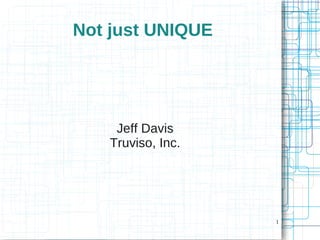
Not Just UNIQUE: Generalized Index Constraints
- 1. Not just UNIQUE Jeff Davis Truviso, Inc. 1
- 2. Why is UNIQUE so unique? ● Only constraint where two tuples can conflict with eachother – That is, the existence of one tuple precludes others from existing ● Effectively a predicate lock on a very simple predicate ● Special code to enforce unique constraint in the BTree code – doesn't work GiST, etc. 2
- 3. Motivation for More General Constraints ● PERIOD data type can represent a period of time: – http://pgfoundry.org/projects/temporal ● Definite beginning and end time, e.g., the period of time during which a professor is teaching in a classroom ● But two professors can't teach in the same classroom at the same time ● So periods of time cannot overlap 3
- 4. Digression: Temporal Data ● Managing temporal data effectively is important and a very common problem. ● Hopefully you saw Scott Bailey's talk earlier – if not, wait for the video. ● Enforcing non-overlapping constraints is one of the few pieces that requires good support in the core PostgreSQL engine. 4
- 5. Non-Overlapping Constraint ● Very commonly known as a “schedule conflict” ● How do you specify a non-overlapping constraint in PostgreSQL currently? ● Any ideas? 5
- 6. Non-Overlapping Constraint ● Very commonly known as a “schedule conflict” ● How do you specify a non-overlapping constraint in PostgreSQL currently? ● Any ideas? ● Most people don't enforce in DBMS ● Maybe with a trigger that takes a full table lock? – Horrible performance 6
- 7. Non-Overlapping Constraint ● If the constraint is not enforced by the database... ● ...then it will be enforced when two professors each believe they have reserved the same room ● A duel? ● Probably a less desirable constraint enforcement mechanism than a friendly error from the DBMS 7
- 8. Operator Exclusion Constraints ● New feature ● Working on getting it accepted for PostgreSQL 8.5 ● Offers more general constraint enforcement mechanism 8
- 10. Example CREATE TABLE reservation ( room TEXT, professor TEXT, during PERIOD, EXCLUSION USING gist (room CHECK WITH =, during CHECK WITH &&) ); Can be arbitrary expression of fields in table. 10
- 11. Example CREATE TABLE reservation ( room TEXT, professor TEXT, during PERIOD, EXCLUSION USING gist (room CHECK WITH =, during CHECK WITH &&) ); Exclusion operator. In this case, “overlaps”. 11
- 12. Example CREATE TABLE reservation ( room TEXT, professor TEXT, during PERIOD, EXCLUSION USING gist (room CHECK WITH =, during CHECK WITH &&) ); Type of index to build and use for enforcement. 12
- 13. Operator Detects Conflicts ● The operator is used to search for conflicts ● Should return TRUE when two values conflict ● Should return TRUE when two values conflict ● So the “overlaps” operator (“&&”) would be used to enforce the constraint that no two tuples contain overlapping values 13
- 14. Back to UNIQUE ● If you specify all operators as “=”, the semantics are identical to UNIQUE ● Performance slightly worse, because one additional index search is required ● But can be used with GiST 14
- 15. UNUNIQUE ● If you specify all operators as “<>”, then constraint is the opposite of unique: all values must be the same! ● However, won't work for types that don't have a search strategy for “<>”. ● Not obviously useful, but it's there. 15
- 16. Multi-Column Constraints ● ... EXCLUSION USING gist (a CHECK WITH =, b CHECK WITH &&) ... ● Tuple1 conflicts with Tuple2 if and only if: – Tuple1.a = Tuple2.a AND – Tuple1.b && Tuple2.b ● Otherwise, both tuples can appear in the table. 16
- 17. Extra Capabilities ● Support for predicates (WHERE) – Constraint on a subset of the table ● Support for arbitrary expressions – ... EXCLUSION ((t::circle) CHECK WITH &&) ... ● Can use other tablespaces and index parameters, similar to UNIQUE. ● Deferrable (work in progress) ● GIN support (work in progress) 17
- 18. Future Work ● Multiple constraints can use the same index ● UNIQUE(a, b) and UNIQUE(a, c) can both use an index on (a, b, c) ● Depending on selectivity of “a”, may perform much better than two separate indexes 18
- 19. Conclusion ● Constraints are always enforced ● Sometimes by the DBMS (cheap), sometimes by real life (expensive) ● The very simple, very common “schedule conflict” constraint is almost impossible to enforce with most DBMSs ● Let's make it easy, scalable, and flexible. ● “Operator Exclusion Constraints” in 8.5 19
